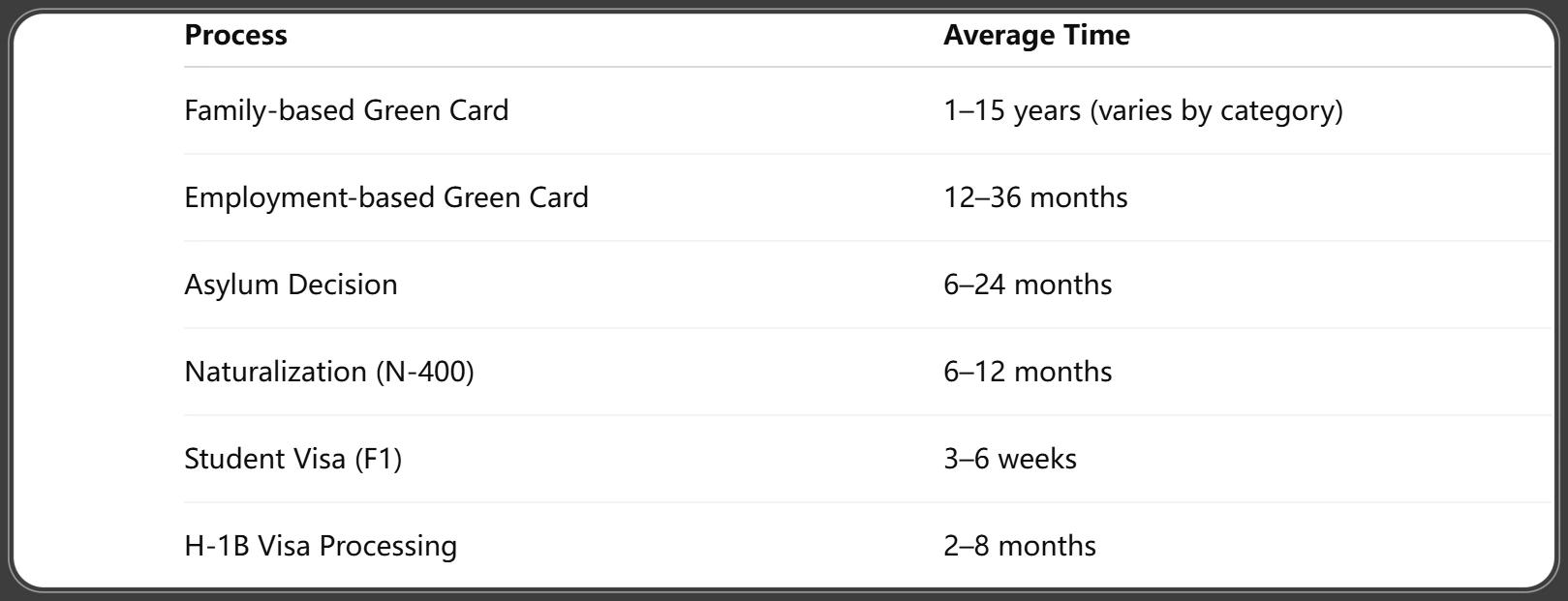US Immigration Process 2025: 18 Critical Steps, Visa Rules, and Policy Changes Explained
Published on August 3, 2025

Emily Johnson, M.A.
International Student Advisor
Emily Johnson, M.A., has over 7 years of experience advising international students on F-1, J-1, OPT, and CPT requirements while ensuring SEVIS compliance.
US Immigration Process 2025: Step-by-Step Guide to the Latest Rules and Reforms
The US immigration process in 2025 is undergoing rapid transformation, powered by technology, changing policies, and new priorities. Whether you're seeking a work visa, a green card, or permanent residency, understanding the updated steps is essential to ensure a smooth and successful journey to the United States.
This comprehensive guide will walk you through the new laws, visa categories, green card pathways, and common mistakes to avoid in 2025.
Overview of the US Immigration System in 2025
The US immigration system operates under several federal agencies:
- USCIS (U.S. Citizenship and Immigration Services): Handles visa and green card applications.
- ICE (Immigration and Customs Enforcement): Enforces immigration laws inside the U.S.
- CBP (Customs and Border Protection): Handles inspections at airports and borders.
- DHS (Department of Homeland Security): Oversees all immigration-related agencies.
Immigration is divided into four primary categories:
- Family-based immigration
- Employment-based immigration
- Humanitarian-based immigration (asylum/refugee)
- Diversity Visa Lottery
Major Policy Changes to US Immigration in 2025
In 2025, several key reforms have reshaped how people apply for visas and permanent residency:
- Faster digital application portals launched by USCIS to reduce paper delays.
- Expanded work visa options for STEM professionals and startup founders.
- Updated biometric and medical screening for all applicants.
- Increased humanitarian pathways, including Temporary Protected Status (TPS) and parole for displaced populations.
These updates aim to modernize the system and address application backlogs.
Step-by-Step Breakdown of the Immigration Process
Here’s how a typical immigration case progresses:
- Petition Filed: A family member, employer, or applicant files Form I-130, I-140, or similar.
- USCIS Review: Application is reviewed and possibly approved.
- Visa Availability Check: Priority dates are tracked using the Visa Bulletin.
- Consular Processing or Adjustment of Status: Choose either an overseas interview or domestic status change.
- Medical & Background Checks: Mandatory for all immigrant applicants.
- Approval & Entry: Receive visa or green card and travel to the U.S.
- Permanent Residency or Citizenship Pathway Begins
Non-Immigrant Visas in 2025
These are temporary visas that allow entry for specific purposes:
- B1/B2 Visas: Business and tourism visitors.
- F1 Visas: International students, with expanded post-graduation work rights.
- H-1B Visas: Skilled workers in tech, healthcare, and finance (subject to an annual cap).
- Startup Visas (New): For international entrepreneurs launching U.S. companies.
- O, L, and TN Visas: For exceptional talent, intra-company transfers, and NAFTA professionals.
Immigrant Visas and Green Card Pathways
Key Pathways:
- Family-sponsored Visas (I-130): For spouses, parents, and relatives.
- Employment-based Visas (I-140): For workers with U.S. job offers.
- EB-5 Investor Visa: For those investing $800,000+ into the U.S. economy.
- Diversity Visa (DV) Lottery: Random selection for nationals of underrepresented countries.
Green Card Application Process in 2025
Step-by-step:
- File Petition (Form I-130 or I-140)
- Wait for Priority Date to Become Current (via Visa Bulletin)
- Submit Form DS-260 (Consular) or I-485 (Adjustment of Status)
- Complete Medical Exam (Form I-693)
- Attend Biometrics Appointment
- Interview at Consulate or USCIS Field Office
- Receive Approval and Green Card
Processing times vary from 6 months to 5+ years, depending on the visa type and country of origin.
Asylum, Refugee, and Humanitarian Immigration
Asylum seekers must prove persecution based on race, religion, nationality, political opinion, or membership in a social group.
Key Points in 2025:
- Faster processing lanes for urgent humanitarian cases
- Expansion of Temporary Protected Status (TPS) for crisis-affected countries
- Humanitarian Parole available in limited cases for health and safety risks
Immigration for Skilled Workers and Entrepreneurs
The U.S. is targeting global talent through special pathways:
- STEM OPT Extensions: Allowing more time for science and tech graduates to work.
- National Interest Waiver (NIW): Skips labor certification for highly skilled applicants.
- Startup Founder Programs: For entrepreneurs with U.S. business plans and capital backing.
Family-Based Immigration Rules and Processing Times
Family immigration remains one of the most common ways to gain lawful permanent residency in the U.S. in 2025. However, processing times vary widely depending on your relationship to the sponsor.
Categories:
- Immediate Relatives: Spouses, unmarried children under 21, and parents of U.S. citizens. No visa limits, typically processed within 10–18 months.
- Family Preference Categories: Siblings, adult children, and spouses of green card holders. Subject to yearly caps, with waits ranging from 2 to 15+ years depending on country of origin.
2025 Updates:
- Digital petition tracking through USCIS portals.
- Faster biometric processing in major cities.
- Priority processing for certain cases involving minor children or elderly parents.
Citizenship Through Naturalization in 2025
Once you have a green card, you may apply for U.S. citizenship through naturalization.
Eligibility Requirements:
- 5 years of permanent residency (3 years if married to a U.S. citizen)
- Continuous physical presence in the U.S.
- Good moral character
- Basic English proficiency
- Pass the U.S. civics test
Process:
- File Form N-400
- Attend biometrics appointment
- Complete interview and civics exam
- Receive decision and oath ceremony date
In 2025, the civics test is more scenario-based, with revised study materials available in multiple languages.
Immigration Medical and Background Check Requirements
Before approval, all applicants must pass strict health and security screenings.
Required Exams:
- Form I-693 medical exam by a USCIS-approved doctor
- Updated vaccine records including COVID-19, measles, and tuberculosis screening
- Background checks through FBI and DHS databases
Refusals may occur if applicants pose public health or national security risks.
How to Track Your Immigration Case in 2025
USCIS now offers enhanced online tools for real-time tracking:
- Case status via USCIS.gov or mobile app
- Email and SMS alerts
- Processing time estimator by form type and location
- Case history logs and support chat through your USCIS online account
These tools can help reduce stress and provide transparency on your case progress.
Common Reasons for Visa Denials or Delays
To avoid setbacks, watch for these common pitfalls:
- Missing or incorrect documentation
- Previous immigration violations (overstay, unauthorized work)
- Inadmissibility issues (criminal record, misrepresentation)
- Inconsistent answers in interviews or on forms
Tip: Always double-check every submission and consult a legal expert if your case is complex.
How Long the US Immigration Process Takes in 2025
Estimated timelines (as of 2025):

Delays are common due to background checks, RFE (Request for Evidence), and document errors.
Legal Help and Immigration Attorneys
Not all cases require an attorney—but complex situations can benefit from legal expertise.
When to Consider Hiring a Lawyer:
- You’ve had previous visa denials
- You’re facing removal or deportation
- You need help navigating asylum or humanitarian programs
- You're sponsoring multiple family members
Free & Low-Cost Help:
- AILA (American Immigration Lawyers Association) directory
- Nonprofit legal clinics in many U.S. cities
- Pro bono immigration attorneys via Catholic Charities, Legal Aid, or IRC
Preparing for Your US Entry and Arrival in 2025
Once your visa is approved, you’ll go through port of entry screening:
- CBP officer interview
- Secondary inspection (if flagged for additional screening)
- Verification of documents, vaccinations, and financial support
Tip: Keep all paperwork easily accessible, including your passport, visa, I-797 approval, and medical documents.
FAQs: US Immigration Process 2025
1. Can I apply for a green card without a sponsor?
Yes. Options include asylum, the EB-5 investor visa, and self-petition under the National Interest Waiver or VAWA.
2. What if I overstay my visa in 2025?
Overstaying can result in bars to re-entry and loss of immigration benefits. Consult an attorney immediately.
3. Is the Diversity Visa Lottery still active in 2025?
Yes, though the number of spots and eligible countries may change. Apply online via the official State Department portal.
4. Can I work in the U.S. while my green card is pending?
If you’ve filed Form I-485, you can also apply for work authorization (EAD) and advance parole for travel.
5. How do I check if a visa is available for me?
Monitor the monthly Visa Bulletin on the U.S. Department of State website to track availability based on category and country.
6. What happens if my visa is denied?
You may appeal or reapply depending on the reason. In some cases, you can request a waiver of inadmissibility.
Conclusion: Navigating the US Immigration Process in 2025 With Confidence
The US immigration process in 2025 is evolving—but with the right guidance, planning, and preparation, your path to a U.S. visa, green card, or citizenship is within reach.
Final Tips:
- ✅ Stay updated on policy changes.
- ✅ Use USCIS tools to track your case.
- ✅ Submit accurate and complete documents.
- ✅ Consider legal help for complex issues.
- ✅ Stay patient—it’s a process, not a sprint.
You Might Also Like
USCIS Employment Based Green Card Backlog 2025: 7 Insights You Can't Ignore
Aug 8, 2025EB3 Processing Time 2025: Latest Updates, Faster Approval Tips & Predictions
Aug 8, 2025EB2 Priority Date India 2025: Key Predictions, Wait Times & Filing Strategy
Aug 5, 2025EB1 Processing Time 2025: How to Speed Up Your Green Card Approval
Aug 5, 2025Employment Based Green Card Process 2025: Full Step-by-Step Guide for Workers and Employers
Aug 4, 2025
